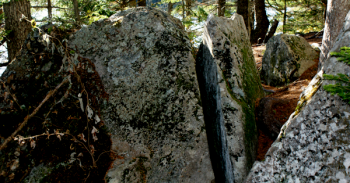Ask Professor Puzzler
Do you have a question you would like to ask Professor Puzzler? Click here to ask your question!
"In your post about triangular mountains, you mentioned ice wedging - can you explain what that is?"
Sure! In fact, I'll do better than just explain; I'll also give a picture. First the explanation. Ice wedging is a form of erosion. And erosion, in case you don't know, is when something breaks down due to wind, water, or other natural forces. Erosion can easily be seen on a mountain trail, where water rushes down the side of the mountain (usually in the spring time, but after any heavy rain) and washes away the dirt. This is why, if you're hiking a mountain, you'll often find trails covered with tree roots. The roots weren't always exposed; the rain washed away the dirt until they were sticking out.
This is also why, on many steep mountain trails, the people who maintain the trails will put logs across the trail at intervals, diagonally placed in such a way that water rushing down the trail will be diverted off into a ditch by the side of the trail. These kinds of devices are called "waterbars," because they are designed to bar the water from flowing down the trail and eroding it.
Okay, so that's erosion, and "ice wedging" is a form of erosion. Ice wedging happens when a rock has a crack in it. When it rains, the crack fills up with water. Now, that's not really a big deal, unless that water freezes inside the crack. Since water expands when it freezes, there's not enough space for all that ice in the crack, so the two sides of the crack get pushed apart by the ice, which causes the boulder to shift, and maybe crack some more. If this process happens repeatedly, the crack gradually becomes bigger and bigger, and eventually the boulder may split entirely.
This is very common at high altitudes, where the temperatures fluctuate a lot from day to night; during the spring time there will be lots of rain, and lots of running water from melting snow, but at night the temperatures drop below freezing.
Here's an example of a boulder near the summit of Cranberry Peak in Stratton, Maine, that was probably split due to ice wedging.



